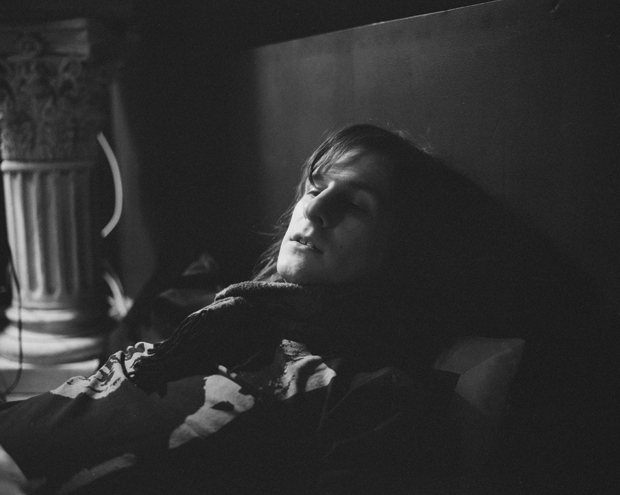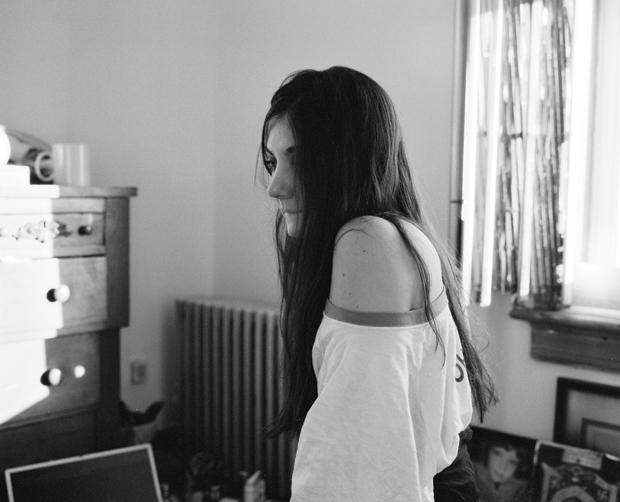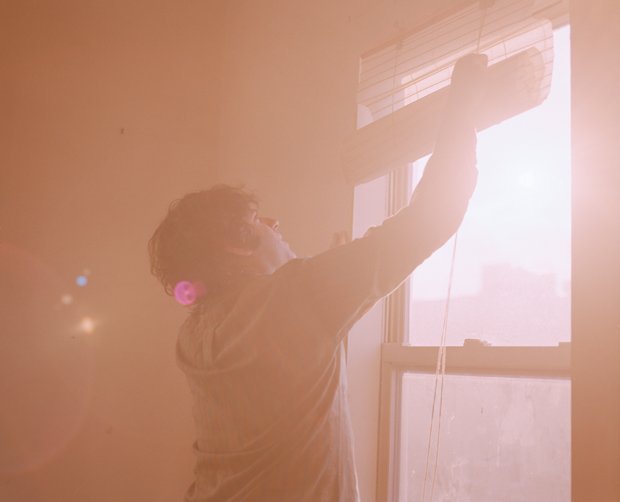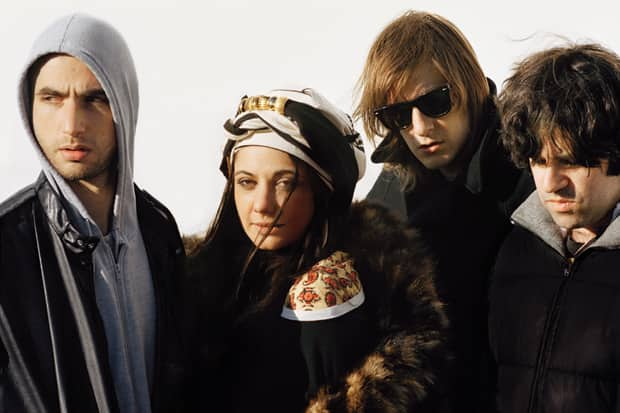Not too long ago, a self-styled downtown New York legend was quoted in the New York Times Magazine in an article about streetwear as saying, “I’m so downtown I don’t go above Canal Street.” It was a hilarious and surprisingly subtle moment for the Times, a paper that would often have you believe that, because of rising rents and changing neighborhoods, the loose scene that is generally known as downtown New York moved to Williamsburg, Brooklyn in the early ’00s and onwards and outwards from there—to Greenpoint, Bushwick, Long Island City, Red Hook and even to East New York. But what the “Canal Street” comment touches on is that, really, the heart of “downtown” has stayed put. The Lower East Side—condos, hotels and all—is still the cultural epicenter of the now-sprawling, multi-borough downtown grid, which means not only that the outer boroughs tend to choose you, but also that downtown, like the cost of living, has grown up.
At a recent photo shoot, Lizzi Bougatsos of the New York-based band Gang Gang Dance got an eyeliner pen out of her bag and wrote “212” on the cheekbone of her bandmate Brian DeGraw. When asked half-jokingly about it a week later, DeGraw offered a mostly musical explanation, saying, “That ‘Brooklyn band’ tag is something that we don’t want to be associated with because it’s become this pigeonhole label—it’s like a genre of weirdo music: ‘Brooklyn noise, blah blah blah, fuckin knob tweakers.’ I’ve never considered Gang Gang to be a part of that. I guess our friends are partly responsible for the creation of that thing, which is cool, but we’ve always just lived on the Lower East Side.” Although DeGraw’s intention was to demand a certain amount of factual correctness and perhaps respect for Gang Gang Dance’s trajectory as a New York band, there is also a status claim of sorts buried in there. Gang Gang Dance isn’t just not a band of nouveaux weird-for-weird’s sake knob twiddlers. It is also, more importantly, a Manhattan band born out of the final throes of one era of downtown New York that is now awkwardly, finally maturing in another era of downtown entirely. It has proven to be a grueling position to occupy.

Vocalist and percussionist Lizzi Bougatsos, keyboardist and electronic percussionist Brian DeGraw, guitarist Josh Diamond and drummer Tim DeWit formally created Gang Gang Dance in the early 2000s. Their first release Gang Gang Dance came out on a label called Fusetron, then they released an LP (Revival of the Shittest) and an EP (Hillulah) on the Brooklyn-based label the Social Registry. Finally, their semi-breakthrough album God’s Money came out on the Social Registry in 2005. God’s Money was the first recording that reflected what the band’s sound has become, born of a tension between tumultuous world-futurism abstractions and a dirty, rhythm-heavy sound that knocks. The band’s bizarre musical vocabulary definitely takes some getting used to, but the rewards are one of a kind—frantic, corner-bending, electro-acoustic rhythms and lush, left-hook melodies. Gang Gang is hyper-aware of the breadth of music bubbling out of all corners of the earth not just in eras past but also right now, and each band member has an active relationship to big swathes of sounds. It is evident if you go hear DeGraw DJ at the wildly popular Morrissey party at Sway on Sunday nights, where he sandwiches all manner of hectic electronic and street music between his DJ partner Benjamin Cho’s plays of “Shoplifters of the World Unite” and “The Boy With the Arab Strap.” And his band is actually pulling from all those sounds: from the skittering clomps of grime, the quavering vocal lines of Hindi film music, the slick club bounce of hip-hop, the pillow-y synthetics of new age and the frantic booms and one-hand keyboard twinkles of dancehall. But even before all that, Gang Gang Dance’s story is a New York story, beginning with the fact that, like much of New York, none of the four band members are from the city.
Bougatsos is from Long Island where, as a kid, she devoted herself to modern dance, then moved to West Virginia for an art degree and earned a reputation opening for punk bands with spoken word performance art. Diamond had a high school band in State College, Pennsylvania, moved to DC for a year, then moved to New York in 1995, where he worked at the Pink Pony on Ludlow Street, hosting avant jam sessions, playing violin and supplying then-broke downtowners with free caffeine. DeWit grew up in Grand Rapids, Michigan, where he was an indie rock singer-songwriter. After high school—inspired by Teen Beat records—he moved to DC. DeGraw grew up a New Haven hardcore kid who ended up at Corcoran College of Art + Design in DC because Nation of Ulysses was from Washington. He enrolled to study fashion photography, but his two favorite professors told him to leave. Art school, they said, is for people who want to learn how to be artists, not for those who already are.

Josh Diamond had left DC by the time Brian DeGraw and Tim DeWit arrived there separately, but the magnetic pull of the capitol as an imagined underground utopia for an entire generation of kids who grew up on hardcore is essential to the current American underground musical landscape in general, and to Gang Gang Dance in particular. Although DeGraw and DeWit met and eventually moved into the Embassy, the group house that was founded by Nation of Ulysees in DC’s Mount Pleasant neighborhood, both skim over their arrival at a punk rock mecca in the mid-’90s and instead focus on their discovery of other cultures there. “There’s nothing to do in DC, so everyone just spent all their time learning about different kinds of music,” DeGraw says. “Because of the Ethiopian side of the neighborhood that we lived in, Ethiopian music was obviously the main thing that we could physically access.” DeWit, meanwhile, initially moved into a predominately black DC neighborhood while working a job at Tower Records. He had never so much as heard hip-hop before, but was suddenly immersed in black culture, smoking weed for the first time, getting exposed to hip-hop, jungle, trip-hop and go-go and generally bugging out.
As the cultural fabric of Washington DC began to rearrange DeGraw and DeWit’s musical imaginations, DeGraw simultaneously talked his friend Jim Loman into moving to DC, where the trio linked up with guitarist Raquel Vogl and formed the Crainium. Loman not only implemented a sort of punk-feminist manifesto for the band, but also enforced a schedule of hyper-regimented practices. Soon they were touring and recording an album produced by Guy Picciotto from Fugazi. “Basically the process taught us discipline,” DeWit says of the Crainium. “And I transformed so much during that time that I stopped doing any sort of drugs or drinking or having sex. I was looking for some new gender in this new…it was this crazy artsy weird kid shit, and music was the sacred thing.” Although DeWit remained in the Crainium, he increasingly recognized his detachment from the DC punk community. “Through those realizations of myself,” DeWit says, “I started to play music with free jazz guys that had kicked heroin and been in Vietnam and they were just blowing their horns and feeding off my energy, then I would go to Crainium practice and then I also got involved in this theater group.” The theater group was named Vashti, after the woman who refused to undress for the king in the Bible’s book of Esther. “I started meeting thugged out house producers and thugged out gay dancers and having these jam sessions,” DeWit continues. “Everyone was just rocking out and I was the one playing drums and there were dancers hanging off poles and lesbian MCs who hated my guts because I was this white dude, but slowly I started to win them over and they were in my face freestyling like, ‘Uh! Keep it tight!’ I’m getting goose bumps just thinking about it, you know? That felt so much more revolutionary than being in this obscure avant punk band.”

When that avant punk band eventually dissolved, DeGraw began considering a move to New York where he could maybe show his visual art at real galleries, and eventually DeWit and Loman made the move with him. Soon DeGraw and DeWit were going to art and fashion parties and performing informally with various collaborators including Bougatsos, who had continued to do performance art and sing, and Diamond. At some point DeGraw and DeWit found a rehearsal space, and it happened to be shared by Animal Collective and Black Dice. “Those guys were a huge influence,” DeWit says. “They were younger than us and they were big Crainium fans, but it was crazy to go to that practice space where we would all jam together—this crazy, psychedelic, break-down-any kind-of-form shit. We were kind of like, We want to make this experiential music too. That’s when Liz and Josh got on board, because both of them could just go for it.” At the time, Gang Gang’s lineup also included a sort of freestyle multi-instrumentalist/performer called Nathan Livingston Maddox. In 2002, Maddox was watching a storm on the roof of a building on Broome St and was suddenly struck by lightening and killed. His death was a massive jolt for the band, but also, eventually, an inspiration. “It started a momentum, I guess,” DeWit says. “We knew we had to respond to that somehow, and we wanted to be more direct. It was like, ‘That’s what dying looks like—we don’t want to do that yet.’”
Although Gang Gang Dance is, as the band insists, a Manhattan band, Josh Diamond lives in a bleak corner of Williamsburg, Brooklyn that’s cut off from the subway stops, the new eateries and the Tasty D-Lite franchise by the elevated menace of the Bronx-Queens Expressway. “I’ve been in New York for 11 years, but I feel really bad for the youth that come here now,” Diamond says. “I’m kind of in hell in some ways—I equate Brooklyn and this community in some ways with hell just because of what I experienced when I was like 19 years old in the Lower East Side. It was a magical time. Seventy-year-old artists hanging out with young people and real fucking freaks. I came here to witness the death of the ’80s New York scene, and now I feel so bad for all these people. We played Oberlin on a tour and every kid was like, ‘I’m moving to Williamsburg!’ and it was like, ‘Oh great—good luck!’ I’m living the same way I was living 11 years ago, and I don’t really feel very good about that. People move here with big dreams all the time, but I don’t know what they’re looking for.”

Even if most of the kids now moving to Williamsburg, Bushwick and Long Island City don’t know what their specific dream is, what they’re probably looking for is the feeling that Diamond found at the Pink Pony and DeWit found in DC with Vashti. If Gang Gang Dance has one foot in a different era of New York City, in many ways it’s because they have that old school, madcap energy—the love of spontaneity, diversity, impulsive collaboration; the desire to play a gig one night, to sit in with friends the next, to help a friend prepare for a fashion show in a week and to have an art show coming up in a month. From the beginning it has been Gang Gang’s blessing and its curse that each of its members are involved in projects outside of the band—it’s almost as though Gang Gang only exists when its four unique elements are in the same place and begin to react and combust. But the band hasn’t figured out how to be both extremely spontaneous and extremely focused. After the early albums, the band made a huge leap forward with God’s Money, yet Gang Gang is still struggling to deliver on the expectations. In the last ten months, the band has spent four weeks sporadically in recording studios, shaping the next album, but everything they’ve recorded is just sitting on DeWit’s computer. Every night he listens through it on his headphones until four, five, six in the morning, but he’s got almost none of the tools (you can’t mix a record on headphones), only some of the know-how and none of the money. There’s tons of incredible material—you can hear the band reaching towards a fully realized sound that combines the messy, transcendent live quality of four musicians jamming in a room together with the crisp, thumping whomp of speakerboxxx beats. But how they can make a record out of all that tape is unclear. In the meantime, the Social Registry is releasing a Gang Gang Dance DVD/CD package called Retina Riddim that was created entirely by DeGraw using the video editing program Final Cut. Armed with tour video he recorded on an amateur camera, DeGraw created an art film collage and an accompanying 25-minute audio piece that he built using isolated scraps of footage as building blocks. It is not the work that fulfills the band’s potential, nor is it meant to be. It is another beguiling addition to the group’s diverse repertoire.
There are plenty of examples of New York musician/artists who were around-the-way local figures that, at some point, stopped doing a little of everything that interested them and poured all their efforts into one project. Some of them have sold a staggering amount of records. Gang Gang Dance is not on that track. The band is talking to bigger labels than the Social Registry, and Brian DeGraw absolutely means it when he says, “We started something, and we gotta fuckin finish it.” But there’s no question that Gang Gang will always be a weird, difficult listen, and DeGraw states clearly that he will continue to do everything—the band, the visual art, the DJing—without finally picking one or the other. “It’s not the easiest thing in the world, but I think it’s all become a unified thing like a whirlpool,” he says. “The more I stick with it, the more I realize that it’s all swirling in on itself and becoming one greater thing.” The concept for the solo art show he’s been working on, for instance, came from realizations he had while DJing, and DJing is an extension of listening to a ton of music and playing in Gang Gang. The idea is to think in a global rather than local context—to try to explode ideas of genre. Within the Gang Gang framework, DeGraw and his bandmates are getting there—pushing further out by collapsing more and more of the world and their ever-farther-reaching experiences of it into their sounds. Somehow the music is simultaneously becoming an increasingly singular vision with an ever more centered, almost primordial rhythm at its heart. But even if the band never makes an album that turns the quartet into something bigger than a New York band, it’s already a landscape much bigger than New York that Gang Gang Dance is concerned with. “We’re basically concerned about World War III,” says DeWit. “I think our music, to me, is some weird way of acknowledging people that I can’t even hear.”

